Lion’s Mane Mushroom: Comprehensive Benefits & Uses Guide
Contents
- What is Lion's Mane Mushroom?
- How Lion's Mane Mushroom Works
- Lion's Mane Mushroom Benefits: From Brain Health to Better Aging
- What is the Best Lion's Mane Supplement?
- How to Get All the Benefits of Lion's Mane Mushrooms
- Lion's Mane Mushroom Side Effects
- Lion's Mane Mushroom Recipes
- Try Lion's Mane for Yourself!
Lion’s mane is a powerful medicinal mushroom with promising benefits for brain health, gut health and nerve regeneration.*
How can a mushroom once used by monks as a concentration aid help with modern maladies? Can something with a bizarre moniker like “monkey head mushroom” actually improve brain function, boost mood, promote gut health and encourage nerve growth?
Whether it reminds you of a Muppet, a truffula tree or an actual lion, this quirky tooth fungus packs much more of a punch than meets the eye. Dive into this guide to discover how lion’s mane mushroom can benefit your health on multiple levels.
What is Lion’s Mane Mushroom?
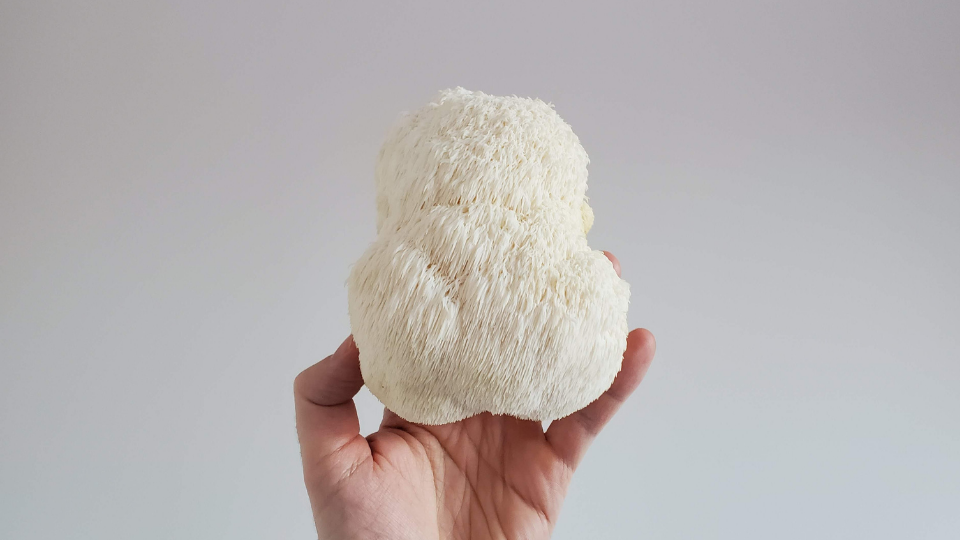
Although its scientific name is Hericium erinaceus, lion’s mane has several nicknames in countries around the world. In Japan, it’s known as Yamabushitake, or the “mountain priest mushroom;” in China, it’s Ho Tou Gu, the “monkey head mushroom.”
Lion’s mane’s shaggy appearance has also earned it titles like:
- Bearded tooth mushroom
- Bearded hedgehog mushroom
- Bearded tooth fungus
- Satyr’s beard
- Pom pom mushroom
These names all point to the unique puffball shape characteristic of lion’s mane mushrooms—which makes them easy to recognize in the wild, at farmers markets or on the rare occasion some pop up at a natural grocer.
This medicinal mushroom shares traits with several edible and non-edible mushrooms known as “tooth fungi.” Although not recognized as a separate scientific category, all tooth fungi grow and reproduce in ways that set them apart from other culinary and medicinal mushrooms. They have no caps or gills but instead distribute spores through long, hair-like “tooth” formations.
A Historical Look at Lion’s Mane Mushroom
Like most medicinal mushrooms, lion’s mane has a long history of use in Asian cultures, including traditional Chinese medicine. It’s still used in China today in pill form as a remedy for gastritis, as well as ulcers of the stomach, esophagus and duodenum*.
According to Chinese records, lion’s mane mushroom cultivation didn’t begin until 1988.
Modern cultivation practices vary, with some growing through the entire life cycle and harvesting the whole mushroom, and others skipping a step allowing for cheap, scalable production—often at the expense of quality. (More on this later.)
Traditional Lion’s Mane Mushroom Benefits
Hericium erinaceus’ claim to fame throughout the centuries was its apparent ability to soothe membranes in the digestive tract.
Traditionally used to combat digestive distress, and stomach problems lion’s mane mushroom was also recognized as a restorative agent for overall health*.
The healing, regenerative nature of lion’s mane was believed to help support*:[1]
- Liver
- Spleen
- Heart
- Lungs
- Kidneys
Any “deficiency” within the body—believed to manifest outwardly with symptoms like insomnia, weakness and loss of strength—was a candidate for treatment with Hericium erinaceus.
Of course, lion’s mane also has a long tradition of use for brain health.
Some cultures recognize the mushroom as an aid for memory, concentration and overall mental function; others point to lion’s mane mushroom for bolstering nerve growth and repair, as well as bringing clarity and focus*.
How to Identify Lion’s Mane Mushroom
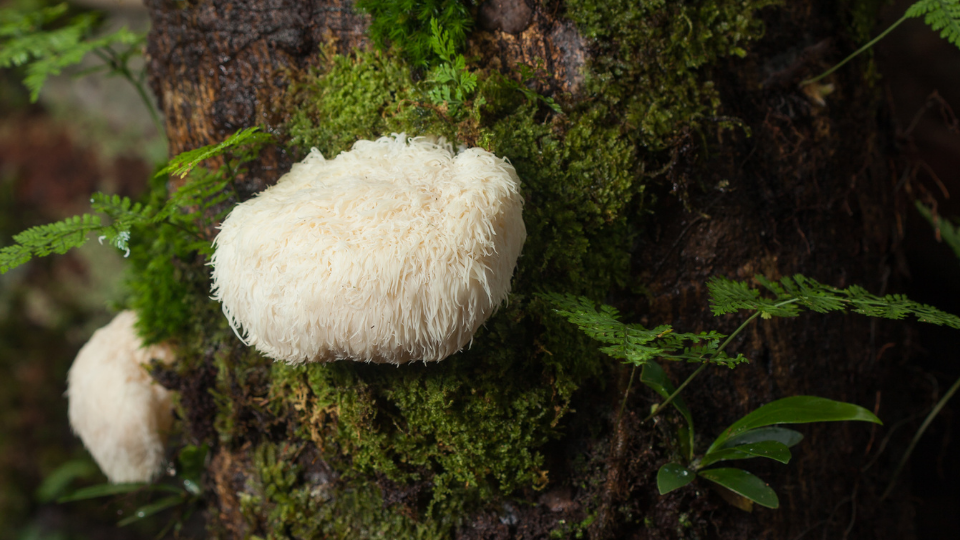
All the “beard” references in nicknames for lion’s mane provide a nearly perfect description; they’re not hard to recognize! However, since several species of tooth fungus exist (and not all of them are tasty), it helps to know what makes lion’s mane unique.
Lion’s Mane Fruiting Body
Hericium erinaceus grows to be 8 to 16 centimeters (around 3 to 6 inches) in size with fluffy “spines” 1 centimeter (just under 0.4 inches) long.[2]
The mushrooms grow in single clumps, with the dangling spines creating a “snowball” appearance.[3]
These spines continue to grow as the mushroom ages.
Color
Fresh, healthy lion’s mane specimens are white in color. Browning can be an indication of damage, but it doesn’t always mean the mushroom is no longer edible. (It just might not taste as good.)
Hericium Varieties
Several other mushrooms keep lion’s mane company in the Hericium genus:
- Hericium americanum, characterized by longer spines
- Hericium coralloides, which grows in “branches” with dangling “hairs”
- Hericium abietis, found in the Pacific Northwest
- Hericium alpestre, a native of Europe
- Hericium cirrhautum, a shell-like variety
All are edible, but lion’s mane is most commonly studied for its health benefits and cultivated for culinary and medicinal use.
Where to Find Lion’s Mane Mushroom in the Wild
For aspiring mushroom foragers, Hericium erinaceus is an easy target. Hairy specimens pop up in the late summer and early autumn in North America, Europe and Asia.
Where does lion’s mane mushroom grow? Look for dead and dying hardwood, particularly fallen logs. Maple, beech, oak, walnut and sycamore can all act as natural substrates.
Watch: Hunting Hericium americanum (Bear’s Head Tooth) and Hericium coralloides (Coral tooth fungus)
Where Can I Buy Lion’s Mane Mushroom?
Those who prefer to “hunt” for mushrooms at the grocery store may be able to find fresh lion’s mane mushroom for sale at farmers markets, Asian markets and neighborhood co-ops. Local growers are also good sources—and, of course, anyone who knows how to forage and is willing to share.
Sourcing mushrooms locally provides the best guarantee of peak freshness, flavor and nutrition. The farther they have to travel, the older they are by the time they hit the shelves, and the more likely they are to be damaged.
Can You Grow Lion’s Mane Mushroom at Home?
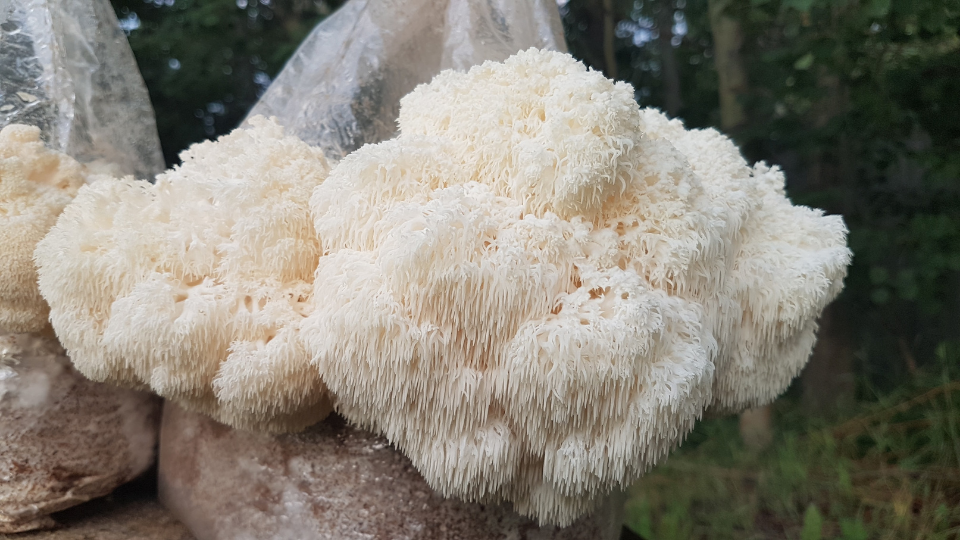
Learning how to grow lion’s mane solves the problem of trying to find this often-elusive specimen. Although Hericium erinaceus can take a good while to grow full maturity in the wild, it’s possible to grow the mushroom at home in a matter of weeks.
A mushroom growing kit is the easiest way to start growing lion’s mane. Because the process doesn’t need anything special aside from humidity, beginners won’t feel overwhelmed by a bunch of complicated cultivation instructions. All that’s needed is to set the kit on a countertop and watch the mushrooms grow!
Advanced mushroom growers (and anyone up for a little more of a challenge) can start with lion’s mane mushroom spawn and a hardwood sawdust substrate.
Harvesting Lion’s Mane Mushrooms
Home-grown specimens are ready for harvest when they’ve become full “snowballs.” All that’s needed is to cut them off at the base and brush away any dirt before cooking.
One caution: Lion’s mane mushrooms bruise easily. Handle with care to avoid damaging the beautiful white fruiting bodies!
Related: Mushroom Growing Kits — Complete Guide, Reviews and Top Picks
How Lion’s Mane Mushroom Works
Lion’s mane contains a variety of functional compounds, but two main players stand out:
- Aromatic hericenones
- Diterpenoid erinacines
No other food contains this powerful duo—which is what makes lion’s mane so special.
The chemical structures of these compounds are a bit complicated. Aromatics are made up of loops connected by covalent bonds (shared electrons). This adds a measure of stability known as aromaticity, hence the name.[4]
Diterpenes—naturally produced by plants, animals and fungi—have four isoprene units. An isoprene consists of two or more hydrocarbon units with specific arrangements of carbon atoms.[5]
Non-erinacine diterpenoids appear in other medicinal mushrooms and exhibit both anti-microbial and anti-inflammatory activity.*[6]
But erinacines can do something particularly unusual that non-erinacines can’t: cross the blood-brain barrier. (Hericenones may share this ability; further study is needed for confirmation.) This stealthy superpower is what gives lion’s mane mushroom its reputation as a brain booster.
Of the numerous types of erinacines that have been identified, lion’s mane fruiting bodies contain two, which are dubbed erinacine A and B. Why is this important? Both of these erinacines have been shown to promote the synthesis of nerve growth factor (NGF)—which has potential applications in addressing a host of neurological conditions and injuries*.[7]
Other erinacines may be found in the mushroom’s mycelium, but erinacines don’t operate alone. The dual action of erinacines and hericenones is most likely the fuel that powers the many benefits of lion’s mane mushrooms. Four of the 11 types of hericenones currently known to science also boost NGF, and all four can be found in lion’s mane fruiting bodies*.[8]
Overall, more than 70 compounds have been identified in *Hericium erinaceus—*and more are being discovered. It may be that these new discoveries will help uncover some of the mysteries as to what makes lion’s mane so mighty.
Lion’s Mane Mushroom Benefits: From Brain Health to Better Aging
Okay, so there’s a lot of amazing chemistry “behind the scenes,” but what is lion’s mane mushroom actually good for?
Science appears to support several traditional uses for the shaggy mushroom, and research is ongoing. Although the majority of studies have been performed on animals or on cells in petri dishes (in vitro), the results show promising potential for ways lion’s mane can benefit human health.
Take a look at what research has revealed about the power of Hericium erinaceus.
1. Linked to Better Brain Health*
The unique ability of erinacines to cross the blood-brain barrier and promote regenerative activity within the brain is the most-cited perk of using lion’s mane mushroom*.
Why is this such a big deal? It all comes down to nerve growth factor (NGF).
Nerve growth factor functions exactly as the name would suggest: It regulates nerve cell growth and reproduction, maintains cellular health and prevents cell death.[9] NGF is part of a family of molecules known as neurotrophic factors, which support both mature and developing neurons.[10]
Neurotrophic factors make it possible for the brain to heal and repair itself after injury and maintain what’s known as “plasticity” throughout life.
In other words, NGF is one of the reasons why you can teach an old dog (or, in this case, human) new tricks. Your brain never stops responding to information, thought patterns and outside stimuli, and NGF helps to strengthen—or even create—important neural pathways in the brain.[11]
But there’s a weird catch.
NGF itself isn’t capable of crossing the blood-brain barrier; the molecule is too big. This isn’t a problem in healthy individuals whose brains make enough NGF. When the brain begins to age, however, levels of NGF and other neurotrophic factors decline.
That’s where Hericium erinaceus comes in. Extracts from the mushroom have the potential to enhance the growth of neurites*. These projections grow out of nerve cells and become either axons or dendrites—the parts of neurons that allow the cells to communicate with each other.
More neurite growth (or regeneration) means better communication and better overall brain function.
Lion’s Mane and Dementia
Problems with cognition can arise when the brain fails to keep up with growing and forming new connections as people age. The resulting cognitive decline can manifest as varying degrees of memory loss or dementia.
Several studies have shown the potential of lion’s mane for dementia prevention and cognitive support*:
- A group of 30 older adults with “mild cognitive impairment” were split into two groups and given either lion’s mane or a placebo. Those supplementing with lion’s mane performed better on cognitive tests at week 8, 12 and 16 of the study*.[12]
- In studies on PC12 cells—used to study brain health and function—lion’s mane appears to prevent damage and reduce the occurrence of cell death*.[13,14]
- Even in healthy subjects,[15] mushroom supplementation may enhance the ability to recognize and recall previously learned information (“recognition memory”) by exerting activity similar to brain-derived neurotrophic factor (BDNF)*.[16] BDNF supports neuronal plasticity, making learning, memorization and recall easier.[17]
Lion’s Mane and Alzheimer’s
Currently, no human studies have been done to examine the effects of Hericium erinaceus on Alzheimer’s patients. In mouse studies, however, extracts of the mushroom were able to reduce symptoms of memory loss and prevent beta-amyloid (β-amyloid) plaque damage*.[18] Since β-amyloid buildup is a key factor in the development of Alzheimer’s, this activity could have significant implications for preventing or even treating the disease*.
Other studies reveal additional ways lion’s mane could help prevent damage associated with both dementia and Alzheimer’s*:
- Hericium erinaceus extracts improved memory and reduced Alzheimer’s symptoms in rat studies*[19]
- The mushroom may up-regulate an anti-inflammatory molecule known as lipoxin A4 within the brain, leading to a reduction in inflammation-related damage suspected of playing a role in cognitive decline*[20]
- In a mouse model of Alzheimer’s, erinacine-A-enriched lion’s mane mycelia showed anti-plaque activity and promoted both NGF and its precursor, leading to neurogenesis (nerve growth) in the hippocampus*[21]
Lion’s Mane Nootropic Properties
Nootropics, sometimes called “smart drugs,” are natural or synthetic substances with beneficial effects on the brain. Lion’s mane mushroom falls into the natural category, making it particularly popular among biohackers looking for an extra mental edge.
Lion’s mane’s stimulating effect comes without the buzz or crash of some other nootropics, most notably caffeine. It also doesn’t share the potential negative side effects of some prescription nootropics*. Instead, the mushroom is touted for its ability to safely enhance cognition, improve memory and support learning*.[22]
Focus and Productivity
These nootropic properties—along with benefits related to improving mood and reducing anxiety—could account for why many people report better focus and productivity when supplementing with lion’s mane*. The active compounds appear to address the root causes of brain fog, which is a common complaint among those struggling with their attention spans*. For this reason, lion’s mane coffee has been gaining popularity as a way to enjoy an extra morning “boost.”
Related: Top 10 Natural Nootropics
2. Depression and Anxiety*
Lion’s mane isn’t only a powerhouse for memory—it may also help with mood. Extracts of Hericium erinaceus appear to regenerate cells in the hippocampus, the area of brain responsible for emotional response and memories*.[23]. In a mouse model, the mushroom showed potential to support neurogenesis, the process of growing new nerve cells*.
The practical daily benefit of all this can be seen in studies relating to anxiety and depression. A four-week trial involving a group of 30 post-menopausal women found that cookies made with lion’s mane won out over placebo cookies for reducing anxiety and irritability*.[24]
Lion’s mane extracts have been shown to block the signalling power of nuclear factor kappa beta (NF-kB), a protein complex responsible for promoting inflammation by inducing synthesis of pro-inflammatory compounds*. The mushroom can also reduce elevated levels of two pro-inflammatory cytokines known as IL-6 and TNF-alpha.[25]
Because inflammation may play a role in some mood disorders, these actions could offer significant benefits for people struggling with anxiety and depression*.
One other thing of note: Lion’s mane mushrooms contain GABA, an inhibitory neurotransmitter that induces relaxation and may have anti-depressant effects*.[26] Concentrations can be increased by boiling the mushroom and fermenting the resulting juice.[27] However, this particular property hasn’t yet been tested in relationship to mood disorders.
3. Heart Health*
Studies have shown that lion’s mane may be able to increase HDL cholesterol, lower both LDL and triglycerides and reduce the amount of cholesterol the body makes*. In addition, a natural polymer from the mycelium appears to be able to lower the atherogenic index, an indicator of overall cardiac risk*.[34]
In an in vitro study, one specific Hericium erinaceus fraction out of five was shown to be “the most potent” inhibitor of LDL oxidation and cholesterol synthesis*. This suggests the potential to reduce cholesterol oxidation that leads to plaquing—and, therefore, prevent blood vessels from narrowing*.[35] Lion’s mane may even prevent the body from metabolizing fats from high-fat foods*.[36]
Taken together, these activities could provide protection against some of the most significant drivers of heart disease, a malady so prevalent in developed nations that arterial plaques have been discovered in babies prior to birth*.[37,38]
4. Inflammation*
Inflammation is coming to the forefront as a prominent factor in numerous chronic diseases. This is likely due to the slow, steady damage induced by inflammation at a cellular level. In cases where ongoing low-grade stress is an issue, this damage can affect any system in the body, thus setting the stage for disease.
Lion’s mane fruiting body extracts have demonstrated potent antioxidant activity, which is just what the body needs when faced with chronic inflammation*.[39]
Antioxidant Power of Lion’s Mane Mushrooms
When the body is stressed or exposed to chemicals—whether in the environment or food—compounds known as free radicals form. Free radicals are missing electrons and will “scavenge” electrons from healthy cells to achieve stability, which touches off an inflammatory cascade that can lead to damage. Over time, this damage causes changes associated with aging, which often include chronic disease.
Antioxidants like those found in lion’s mane have the ability to “donate” electrons to free radicals, which neutralizes the compounds while protecting healthy cells*. The result? Less inflammation and a lower risk of cellular damage*.[40]
According to research, lion’s mane may have specific benefits related to this anti-inflammatory activity*, including:
- Reducing skin aging by boosting levels of skin antioxidants and collagen proteins*[41]
- Reducing pro-oxidant reactive oxygen species (ROS) and increasing antioxidant levels in the brain*[42]
- Boosting antioxidants and reducing lipid peroxidation in diabetic rat models,[43] which suggests potential applications for managing diabetic neuropathy*
Lion’s Mane and Metabolic Syndrome: The Inflammation Connection
Inflammation is also a significant concern in obesity—and together, they’re a dangerous duo of risk factors for metabolic syndrome and full-blown diabetes. Fat cells naturally release pro-inflammatory compounds called cytokines, so being obese increases the likelihood of suffering from chronic inflammation and its consequences. Hericium erinaceus can exert a protective effect by reducing or preventing this inflammation*.[44]
In addition, lion’s mane could potentially reduce the expression of pro-inflammatory cytokines, even when a high fat, high sugar diet is consumed, thereby lowering the risk of metabolic syndrome*.[45] This isn’t a free pass to eat a bunch of junk food, but it does show just how powerful this mushroom can be, even when the metabolic odds are stacked against it.
5. Lion’s Mane and Diabetes*
What about lion’s mane for diabetes*? The current body of scientific evidence suggests this mushroom has benefits beyond its anti-inflammatory activities in cases of metabolic syndrome*. Research in diabetic animal models shows:
- Potential anti-hyperglycemic effects*[46]
- The ability to increase insulin levels and reduce lipids in the bloodstream*[47]
- Antioxidant activity; reduced inflammation; and regulation of HbA1c, insulin and plasma glucose levels*[48]
6. Immune Activity*
Lion’s mane is associated with stronger immune system activity, a characteristic it shares with several other medicinal mushrooms*. It appears to affect immunity by:
- Boosting innate immune activity to protect against bacterial pathogens*[49]
- Exerting anti-inflammatory and anti-cancer effects*
- Boosting natural killer cell activity, enhancing antibody-mediated (humoral) and cell-mediated immunity and improving the ability of macrophages to ingest and destroy pathogens*[50]
- Upregulating secretory immunoglobulin A (SIgA), which protects against toxins and pathogens in the intestine*[51]
How Lion’s Mane Could Improve Gut Health
SIgA secretion is just one of a range of lion’s mane’s gut benefits*. Since nearly 70% of immune tissue is located in the gut,[52] anything that supports a heathier internal ecosystem can directly benefit immune function.
Gut inflammation and an imbalance in gut bacteria (dysbiosis) are two major factors in poor gut health—and, by extension, inadequate or inappropriate immune responses. Lion’s mane mushroom has the potential to reverse dysbiosis, ease inflammation in diseases like colitis and maintain a strong intestinal barrier to prevent pathogens from passing into the bloodstream*.[53]
Lion’s mane may also modulate microbial balance to bring about positive effects on the immune system as a whole, such as:
- Better T-cell proliferation and differentiation, which allows the body to properly target and attack invading pathogens*[54]
- Accurate “training” for the immune system to recognize and eliminate antigens instead of attacking body tissues*[55]
Additional prebiotic properties of the complex carbohydrates in lion’s mane mushrooms may allow the body to recover from microbial imbalances due to inflammatory bowel disease (IBD) or antibiotic use, leading to a reduction in IBD symptoms and better immune system control*.[56]
Related: 9 Immune Boosting Herbs (and Habits) to Stay Healthy All Year
7. Gastric Ulcers*
Here’s one traditional use for Hericium erinaceus that gets the thumbs-up from science. More than one study has shown treating gastric ulcers with lion’s mane appears to reduce their size*.[57]
The mechanisms behind this may include:
- Increasing antioxidant activity to protect the gastric mucosal lining from damage*[58]
- Preventing the growth of H. pylori, commonly associated with ulcer formation*
Lion’s mane’s antioxidant effects may also offer help in cases of colitis*. Alcohol extracts of the mushroom appear to minimize the consequences of inflammatory and autoimmune damage by suppressing pro-inflammatory compounds and upregulating natural antioxidant activity in the body*.[59]
8. Damaged Nerves*
Some of the same properties that make lion’s mane mushroom good for brain health may explain why it’s been shown to help with recovery from nerve injury, nerve pain (neuropathy) and strokes*.
For example, one in vitro study showed lion’s mane extract was able to speed up development of the protective myelin sheath around nerves in cultured brain cells while promoting “normal” cell growth*.[60] In another study using animal cells, extracts promoted neurite growth in both brain and spinal cord models*.[61]
A study directly addressing nerve injury in rats indicated lion’s mane mushrooms have the ability to regenerate nerves and improve recovery, possibly by promoting relevant nerve signaling pathways and axon protein synthesis*.[62,63] Other research using erinacine-enriched lion’s mane mycelia to address neurodegeneration in an animal model demonstrated a delay in neuronal cell death and suggested potential for improving recovery from both hearing loss and pain associated with nerve damage*.[64]
Demyelination
By promoting normal nerve cell growth and supporting myelination, it’s possible that extracts from lion’s mane mushroom fruiting bodies could help people suffering from multiple sclerosis*.[65] This hasn’t officially been studied, but other properties of the mushroom—including its anti-inflammatory activity and ability to promote NGF production—also suggest potential applications in treating or improving this condition*.
Lion’s Mane and Parkinsons
Brain benefits from Hericium erinaceus appear to go beyond preventing cognitive decline*.
- Preventing apoptosis from oxidative stress*
- Inhibiting neuronal cytotoxicity*[66]
In models of ischemic stroke—strokes brought on by restricted blood flow leading to lack of oxygen in the brain—lion’s mane has been shown to reduce inflammatory cytokines and the biomarkers that suggest the presence of ROS*. Suppressing these two compounds may prevent stroke-induced damage*.[67]
9. Could Support Longevity and Well-Being*
For centuries, Eastern cultures have recognized medicinal mushrooms’ ability to improve overall health—and many believed these powerful fungi could also lengthen life*.
Sounds like the dream of a mystical fountain of youth, right? There might be more to it than that.
Oxidative stress from any source creates free radicals in the body. Free radicals running amok leads to cell damage, and cell damage is a big culprit in the aging process.
And then there are telomeres. Telomeres are specific sequences at the ends of DNA strands. They can be thought of somewhat like the plastic tips that keep shoelaces from unraveling—because it’s the job of telomeres to protect DNA strands from damage.[68] Every time cells divide, though, telomeres get shorter, a process that limits how many times a particular cell line is able to replicate.
Oxidative stress can speed up this natural shortening process.[69] (That might explain why it seems like stress accelerates aging—science is starting to show this could actually be the case!) Antioxidant compounds like those found in lion’s mane, however, have the potential modulate these effects*.[70]
The key here appears to be brain-derived neurotrophic factor. BDNF is known for its role in promoting learning and memory,[71] but it can also regulate telomerase, the enzyme involved in maintaining telomere length.[72] Lion’s mane may promote telomerase activity by:
Along with the numerous other known and emerging benefits of the mushroom, these factors suggest Hericium erinaceus can make it possible to enjoy a healthy, vibrant life at any age*.
What is the Best Lion’s Mane Supplement?
Choosing supplements should always be a careful process. Because natural supplements, including medicinal mushrooms, aren’t specifically regulated, not every manufacturer is honest about what’s in their products.
For Hericium erinaceus supplements, it’s important to look for products made from whole fruiting bodies. Avoid artificial ingredients, binders, fillers, grains and starches.
If mycelium and substrate are listed on the label, it’s likely the supplement contains more starch than actual lion’s mane.
And what’s the point of supplementing with starch if the real benefits are in the mushrooms?
How Lion’s Mane Extract is Made
Medicinal mushroom extracts and powders are made using one of three processes: water extraction, alcohol extraction or dual extraction.
In water extraction, mushrooms are simmered in vats of hot water to make a decoction, sort of like strong tea. Alcohol extraction involves soaking mushrooms in alcohol for several weeks.
Performing both processes separately and combining the result creates a dual extract, which contains both the water soluble and fat soluble compounds.
Here’s what it looks like step by step at a company like FreshCap:
- Harvest and dry whole lion’s mane fruiting bodies
- Mill the dried mushrooms into a fine powder
- Perform a hot water extraction, or alcohol extraction (we do both)
- Use spray drying to turn the extracted liquid into a powder
- Combine the powders if dual extraction was performed
Lion’s mane mushroom fiber is sometimes also includes in the final product. This is the “slurry” part of extracts that contains both solids and liquid.
How Much Lion’s Mane Does it Take to Make a Mushroom Extract?
It typically takes 12 kilograms (about 26.5 pounds) of lion’s mane to make 1 kilogram (2.2 pounds) of water extract—that’s a 12:1 ratio. Alcohol extracts are closer to 10:1, but ratios can vary.
Either way, it’s a lot of powerful mushroom compounds in a small amount of extract!
Lion’s Mane Mushroom Capsules vs. Powder
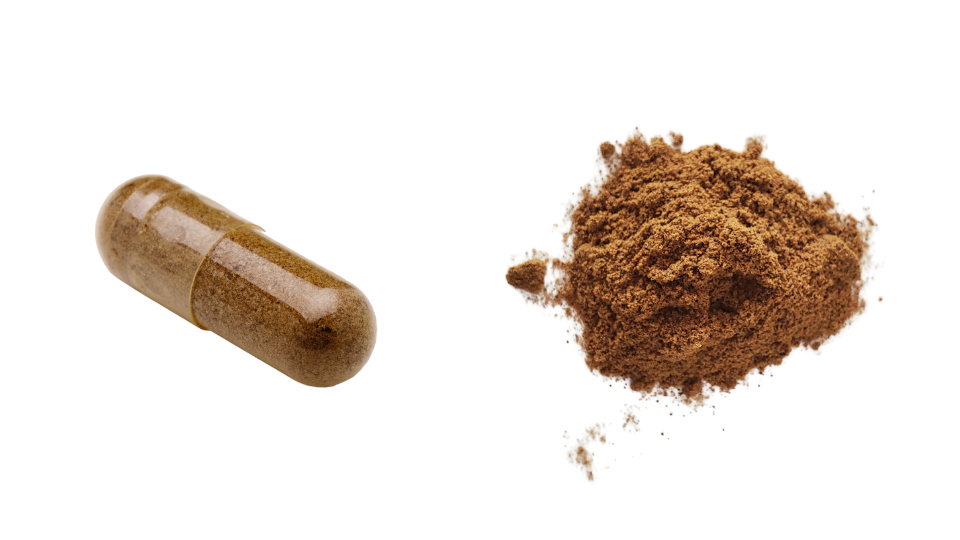
Hericium erinaceus is available in capsules, powders and tinctures. The mushroom also appears in functional foods like coffee, elixirs and drink mixes; dried lion’s mane can be brewed into tea.
The “best” form of lion’s mane supplement is whatever form makes sense for a person’s lifestyle. Each type has its benefits:
- Tinctures are quick and easy to take
- Capsules fit easily into existing supplement regimens
- Powders can be incorporated into a variety of drinks and foods
As long as the supplement is adequately extracted and of high quality, form should have no impact on benefits.
Hericium erinaceus supplements are available at natural supplement stores and online. FreshCap offers dual-extracted lion’s mane powder and capsules made from fruiting bodies with no grain or fillers.
Does Mushroom Coffee with Lion’s Mane Work?
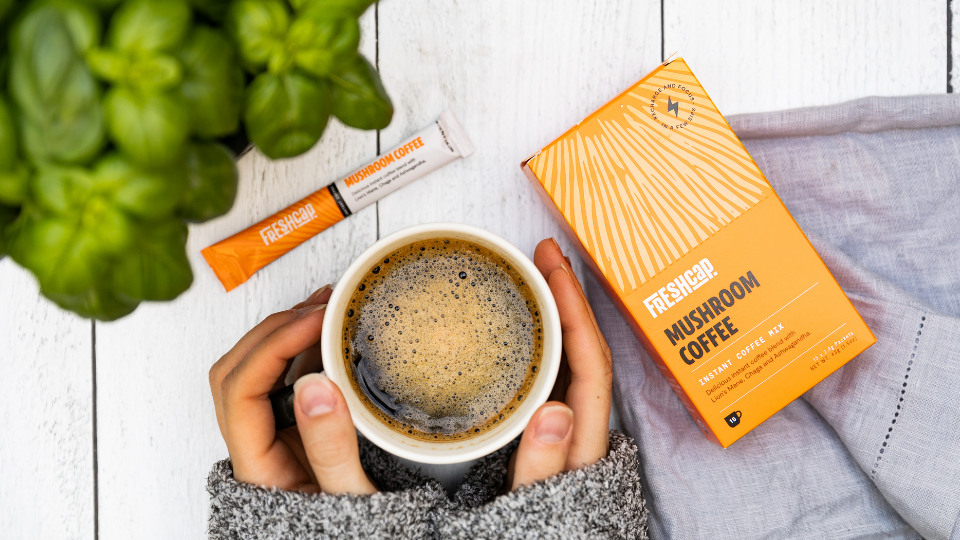
Mushroom coffee is a hot item and growing in popularity. But is it really worth the hype?
There’s not specific science to support any potential benefits of combining medicinal mushrooms with coffee in particular, but given that both lion’s mane and caffeine are natural nootropics, it makes sense that putting the two together could have a compound effect on energy and focus*.
Dose, extraction process and the purity of the mushrooms could all influence how well this brain-boosting combination may work*.
Make it Yourself: DIY Mushroom Coffee Recipe
How to Get All the Benefits of Lion’s Mane Mushrooms
Natural supplements work best when used consistently over time—and medicinal mushrooms are no exception. That means supplementing with Hericium erinaceus requires a little patience to see all the benefits.
If positive effects don’t seem evident after taking lion’s mane supplements for a while, stop for a short time to see if there’s any noticeable difference. The best results usually come when lion’s mane is part of a regular routine.
Lion’s Mane Mushroom Uses
Brain health, mental clarity and focus are the top reasons why many people reach for lion’s mane mushrooms*. In addition to improving mental function, Hericium erinaceus is also used for:
- Reducing stress*
- Improving sleep*
- Increasing productivity*
- Supporting gut health (and, by extension, immunity)*
Remember that no natural supplement should be used in place of professional medical attention. If physical or mental symptoms persist or worsen, get evaluated by a doctor.
When to Take Lion’s Mane
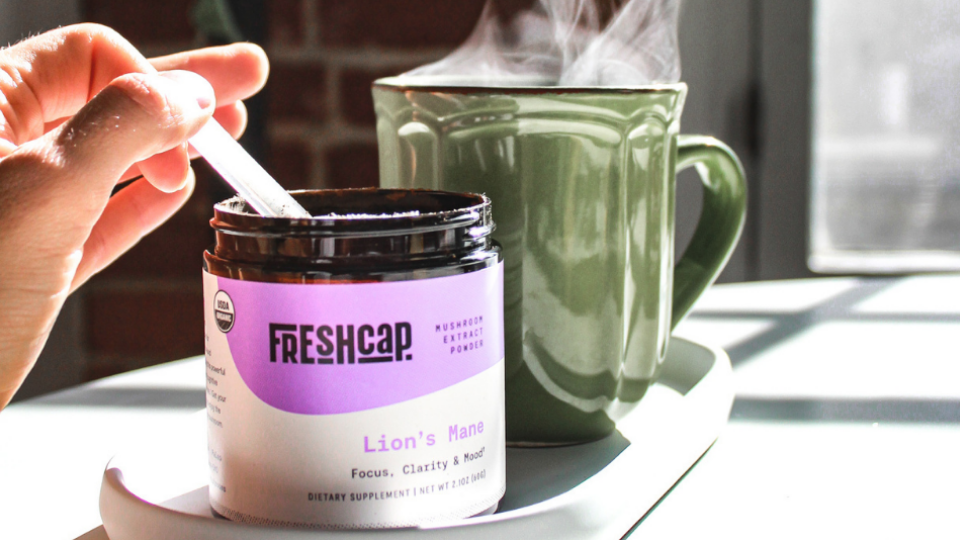
Is there a best time to take lion’s mane mushroom*? It depends on the desired outcome.
Putting mushroom powder in a morning cup of coffee or post-workout smoothie can provide a brain boost to jump start the day. Supplementing in the middle of the day can help overcome the dreaded “mid-afternoon slump”—without caffeine or sugar!
Paradoxically, this brain-enhancing mushroom can also be beneficial when taken before bed. Some people find Hericium erinaceus relaxing and are able to sleep better thanks to its stress-reducing effects*.
When taking lion’s mane more than once per day, space the doses out. Experiment with different times to test the effects and find the most beneficial pattern for supplementation.
Trouble Sleeping? Learn how taking lion’s mane before bed might help.
How Much Lion’s Mane Mushroom Should I Take Per Day?
Medicinal mushroom dosage varies by type and form. Suggested daily doses for lion’s mane are:
- 0.5 – 2 gram of fruiting body extract*
- 3 grams + of fruiting body powder*
Note that there currently isn’t enough scientific evidence available to provide accurate dosing information for specific conditions.[75] Start with small, consistent doses, and monitor the results before deciding whether to take more, and work with a natural healthcare practitioner if you’re unsure of the best way to incorporate lion’s mane into your regimen*.
Consistency is key. Taking mushroom extract or powder every day provides the best results*. And feel free to use fresh lion’s mane as a culinary mushroom any time!
Lion’s Mane Mushroom Side Effects
To date, there haven’t been any human studies on whether or not Hericium erinaceus can have negative effects*. The only reported symptoms are likely the result of mushroom allergies.
Animal studies show supplementing with lion’s mane is apparently safe at high doses for up to one month and low-to-moderate doses for up to three months*. As a dietary supplement, the mushroom is considered safe for humans for up to 16 months*.[76]
Unusual reactions to lion’s mane products in people who aren’t allergic to mushrooms could indicate a poor-quality product. Check the source and contents of supplements prior to beginning a regimen.
How Safe are Lion’s Mane Mushroom Supplements?
When obtained from reputable sources and used as advised, there’s no known reason to fear side effects from taking Hericium erinaceus*. However, there are a few important considerations:
- Don’t supplement when pregnant or nursing
- Consult with a doctor when taking medications or dealing with specific health conditions
- Avoid taking lion’s mane prior to surgery or if a bleeding disorder is present since the mushroom can slow clotting
- Monitor blood sugar for hypoglycemia when supplementing in conjunction with diabetes treatments
Is Lion’s Mane Addictive?
It’s reasonable to wonder if a natural “brain enhancer” has any potential addictive properties. But rest assured, it’s not like a drug! Lion’s mane mushroom, with its apparently low risk of side effects, is a much safer choice than synthetic nootropics*.
One thing to note: Some people have reported mild psychoactive effects from taking lion’s mane supplements despite the fact that the mushroom isn’t a psychedelic. Erinacines can activate kappa opioid receptors, but it’s unclear how or if this may affect perception at normal supplemental doses.
Lion’s Mane Mushroom Recipes
Because lion’s mane isn’t bitter like some other medicinal mushrooms, it works well as a versatile ingredient. Lion’s mane powder incorporates easily into smoothies, energy bars and other homemade “functional foods” without impacting the flavor.
Of course, there’s no treat like fresh Hericium erinaceus, whether foraged, homegrown or store bought. It’s simple to prepare and makes a delicious addition to a variety of dishes.
What Does Lion’s Mane Taste Like?
Ask most people this question, and you’ll get a common answer: “Seafood.”
The light, sweet flavor of this mushroom has been likened to shellfish like crab, which explains its popularity as an ingredient in vegan “crab cake” recipes. It’s not an overly fishy seafood taste—but it’s just enough to fool the brain without overpowering the taste buds.
Because lion’s mane is soft and somewhat spongy or springy, it’s great in saucy, savory dishes that have lots of spices. The mushroom soaks up the flavor and becomes even more delicious as it cooks.
Is Lion’s Mane Mushroom Healthy?
It’s hard to find exact nutrition information for Hericium erinaceus, but the available data is similar to other culinary mushrooms. Sources show somewhere between 35 and 50 calories per 100 grams of raw mushrooms, two to four grams of protein and around seven grams of carbs (some of which is fiber).
As far as the nutrient profile goes, lion’s mane is a source of:
- Zinc
- Potassium
- Selenium
- Polysaccharides (complex carbs with additional health benefits)
Lion’s mane mushroom supplements don’t usually provide specific nutrients and shouldn’t contribute a significant amount of starch to the diet if no fillers are present. But they are great sources of the compounds that give lion’s mane its health-boosting power!
How to Cook Lion’s Mane Mushroom
No special culinary prowess is required to make tasty lion’s mane mushroom dishes. Here’s how to have them come out perfect every time:
- Brush off any dirt or gently wash and squeeze out all the excess water
- Pull apart or chop into bite-sized pieces
- Drop into a hot pan along with some onions and garlic to sauté or blacken
- Add seasonings like thyme, parsley, rosemary and/or lemon—but no liquid, or the mushrooms will get soggy
- Cook longer for a chewier texture
Enjoy the finished mushrooms as a side dish, on top of pizza, mixed into mac and cheese, on top of salad or incorporated into a brain-boosting burger. It’s also great with pasta or as a seafood substitute in traditional shellfish recipes.
These are just a few ideas. Experiment to discover and create tasty new favorites. (And tag @freshcapmushrooms on Instagram to show off your recipes!)
Fresh Ways to Use Lion’s Mane Mushroom Powder
Prefer to make lion’s mane a daily habit instead of an occasional treat? Try these recipes to power up your brain with supplemental powder:
- Lion’s Mane Matcha Latte
- Lion’s “Manego” Smoothie
- Lion’s Mane Energy Balls
- Brain Boosting Lion’s Mane Smoothie
- Dairy-Free Queso Sauce with Lion’s Mane
- The Ultimate Coffee Smoothie
- Supercharged Chocolate Bark
Try Lion’s Mane for Yourself!
The lions mane mushroom is not only beautiful and delicious; it’s also supercharged with compounds that have the potential to improve your brain*. These claims are backed up with both anecdotal evidence and thorough scientific research, which is more than can be said for a lot of brain-boosting tricks*.
Since there is no known harm from ingesting lion’s mane at supplemental doses, it’s worth it to give the mushroom a try and see if it works for you*.
No matter our age, occupation, goals or dreams, we could all benefit from a mental boost, right*? And you can’t really go wrong with a mushroom that looks like a Muppet (or a beard, or a monkey head…).
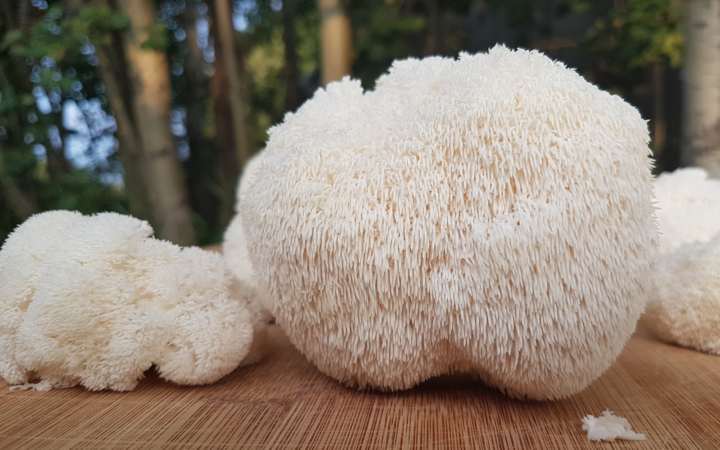

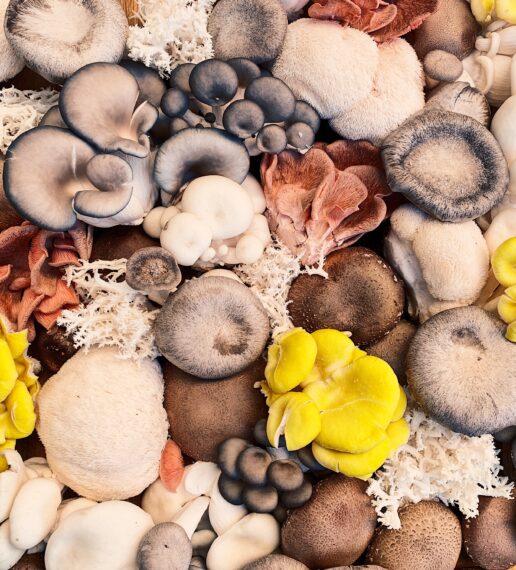

This is the most comprehensive and excellent article that I have read on the subject! Thank you! I am on Lion’s Mane and I love it, but I was wondering if Lion’s Mane is safe for use in children? I have been researching this for a while as I have a child with ADHD, but have never found whether it is safe in the long-term or a suggested dosage for children. I have seen that Lion’s Mane can interfere with Androgens, but am unsure whether this is true?
The mushroom makes you want to grow it. It effects that part of the brain. That’s the biggest side effect 🙃
hahaha, totally!